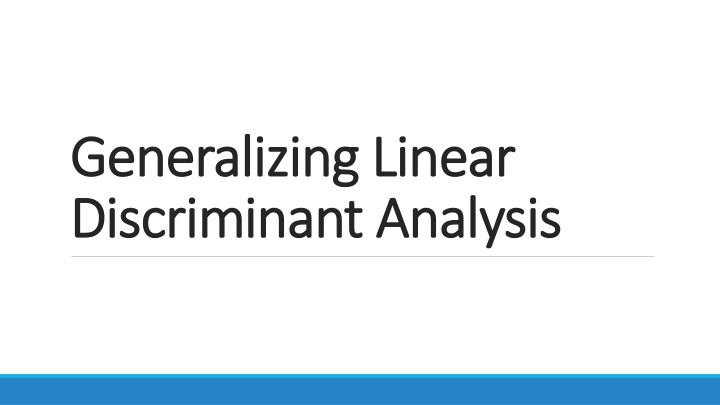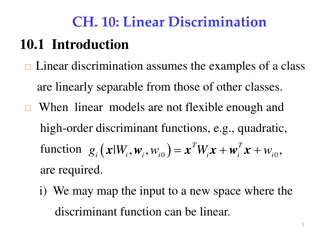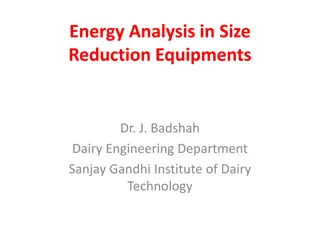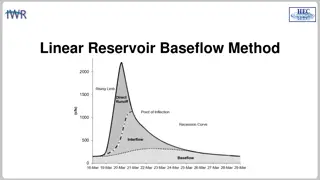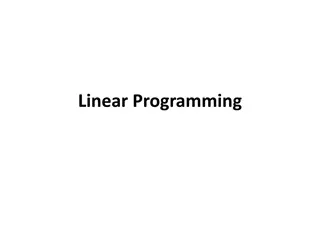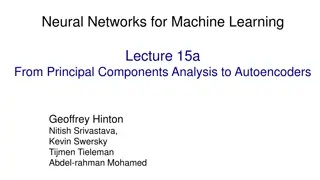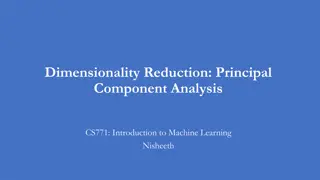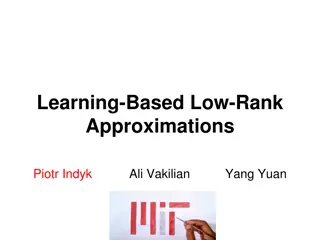Linear Discriminant Analysis in Dimensionality Reduction
Linear Discriminant Analysis (LDA) is a technique used to project a high-dimensional feature space onto a lower-dimensional space while maintaining class separation. By focusing on means and finding dimensions that separate them effectively, LDA helps reduce computational costs and minimize overfitting. This analysis aims to preserve discrimination ability in a reduced dimensionality setting, as illustrated through various figures and equations.
Download Presentation

Please find below an Image/Link to download the presentation.
The content on the website is provided AS IS for your information and personal use only. It may not be sold, licensed, or shared on other websites without obtaining consent from the author.If you encounter any issues during the download, it is possible that the publisher has removed the file from their server.
You are allowed to download the files provided on this website for personal or commercial use, subject to the condition that they are used lawfully. All files are the property of their respective owners.
The content on the website is provided AS IS for your information and personal use only. It may not be sold, licensed, or shared on other websites without obtaining consent from the author.
E N D
Presentation Transcript
Generalizing Linear Generalizing Linear Discriminant Analysis Discriminant Analysis
Linear Discriminant Analysis Objective -Project a feature space (a dataset n-dimensional samples) onto a smaller -Maintain the class separation Reason -Reduce computational costs -Minimize overfitting
Linear Discriminant Analysis Want to reduce dimensionality while preserving ability to discriminate Figures from [1]
Linear Discriminant Analysis Could just look at means and find dimension that separates means most: Equation from [1]
Linear Discriminant Analysis Could just look at means and find dimension that separates means most: Equations from [1]
Linear Discriminant Analysis Figure from [1]
Linear Discriminant Analysis Fisher s solution.
Linear Discriminant Analysis Fisher s solution Scatter: Equation from [1]
Linear Discriminant Analysis Fisher s solution Scatter: Maximize: Equations from [1]
Linear Discriminant Analysis Fisher s solution Figure from [1]
Linear Discriminant Analysis How to get optimum w*?
Linear Discriminant Analysis How to get optimum w*? Must express J(w) as a function of w. Equation from [1]
Linear Discriminant Analysis How to get optimum w*8 Equation from [1]
Linear Discriminant Analysis How to get optimum w* Equations modified from [1]
Linear Discriminant Analysis How to get optimum w* Equation from [1]
Linear Discriminant Analysis How to get optimum w* Equation from [1]
Linear Discriminant Analysis How to get optimum w* Equations from [1]
Linear Discriminant Analysis How to generalize for >2 classes: -Instead of a single projection, we calculate a matrix of projections.
Linear Discriminant Analysis How to generalize for >2 classes: -Instead of a single projection, we calculate a matrix of projections. -Within-class scatter becomes: -Between-class scatter becomes: Equations from [1]
Linear Discriminant Analysis How to generalize for >2 classes Here, W is a projection matrix. Equation from [1]
Linear Discriminant Analysis Limitations of LDA: -Parametric method -Produces at most (C-1) projections Benefits of LDA: -Linear Decision Boundaries Human interpretation Implementation -Good classification results
Flexible Discriminant Analysis -Turns the LDA problem into a linear regression problem.
Flexible Discriminant Analysis -Turns the LDA problem into a linear regression problem. - Differences between LDA and FDA and what criteria can be used to pick one for a given task? (Tavish)
Flexible Discriminant Analysis -Turns the LDA problem into a linear regression problem. - Differences between LDA and FDA and what criteria can be used to pick one for a given task? (Tavish) Linear regression can be generalized into more flexible, nonparametric forms of regression. (Parametric mean, variance )
Flexible Discriminant Analysis -Turns the LDA problem into a linear regression problem. - Differences between LDA and FDA and what criteria can be used to pick one for a given task? (Tavish) Linear regression can be generalized into more flexible, nonparametric forms of regression. (Parametric mean, variance ) Expands the set of predictors via basis expansions
Flexible Discriminant Analysis Figure from [2]
Penalized Discriminant Analysis -Fit an LDA model, but penalize the coefficients to be more smooth. Directly curbing overfitting problem
Penalized Discriminant Analysis -Fit an LDA model, but penalize the coefficients to be more smooth. Directly curbing overfitting problem Positively correlated predictors lead to noisy, negatively correlated coefficient estimates, and this noise results in unwanted sampling variance. Example: images
Penalized Discriminant Analysis Images from [2]
Mixture Discriminant Analysis -Instead of enlarging (FDA) the set of predictors, or smoothing the coefficients (PDA) for the predictors, and using one Gaussian:
Mixture Discriminant Analysis -Instead of enlarging (FDA) the set of predictors, or smoothing the coefficients (PDA) for the predictors, and using one Gaussian: -Model each class as a mixture of two or more Gaussian components. -All components sharing the same covariance matrix
Mixture Discriminant Analysis Image from [2]
Sources 1. Gutierrez-Osuna, Ricardo CSCE 666 Pattern Analysis Lecture 10 http://research.cs.tamu.edu/prism/lectures/pr/pr_l10.pdf 2. Hastie , Trever, et al. The Elements of Statistical Learning: Data Mining, Inference, and Prediction. 3. Raschka, Sebastian - Linear Discriminant Analysis bit by bit http://sebastianraschka.com/Articles/2014_python_lda.html
